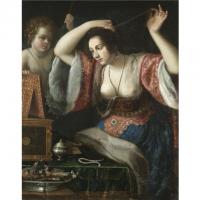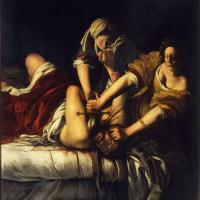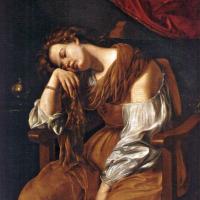Artemisia Gentileschi
Artemisia Gentileschi
Artemisia Gentileschi (1593-1656)
Artemisia Gentileschi or Artemisia Lomi (July 8, 1593 – 1656) was an Italian Baroque painter, today considered one of the most accomplished painters in the generation following that of Caravaggio. In an era when female painters were not easily accepted by the artistic community or patrons, she was the first woman to become a member of the Accademia di Arte del Disegno in Florence and had international clientele.
She specialized in painting pictures of strong and suffering women from myths, allegories, and the Bible—victims, suicides, warriors. Some of her best known themes are Susanna and the Elders (particularly the 1610 version in Pommersfelden) and Judith Slaying Holofernes (most famous is her 1614–20 version in the Uffizi gallery) and Judith and Her Maidservant (her version of 1625 at the Detroit Institute of Arts).
She was known for being able to convincingly depict the female figure, anywhere between nude and fully clothed. Artemisia was also famous for her skill and talent in handling color, both overall in the composition but also in building depth.
That she was a woman painting in the seventeenth century and that she was raped as a young woman by Agostino Tassi and participated in the prosecution of her rapist long overshadowed her achievements as an artist. For many years she was regarded as a curiosity. Today she is regarded as one of the most progressive and expressive painters of her generation.
The first writer who produced a novel around the figure of Artemisia might be George Eliot in Romola (1862–63), where some aspects of Gentileschi's story, while set in Florence in Gentileschi's time, are recognizable, but much embroidered. A later and clearer use of Gentileschi's story is by Anna Banti, wife of Roberto Longhi. Her first draft of the manuscript, dated 1944, was lost during the war. Three years later she started again with the book, to be entitled Artemisia, writing in a much different form. Banti's book is written in an "open diary" form, in which she maintains a dialogue with Artemisia, trying to understand why she finds her so fascinating.
Gentileschi is one of the women represented in The Dinner Party, an installation artwork by Judy Chicago that was first exhibited in 1979.
Artemisia, and more specifically her painting Judith Beheading Holofernes, are referred to in Wendy Wasserstein's 1988 play, The Heidi Chronicles, where the main character, Heidi, lectures about it as part of her art history course on female painters. At the end of the play, Heidi adopts a daughter she names Judy, which is at least a partial reference to the painting. Canadian playwright Sally Clark wrote several stage plays based on the events leading up to and following the rape of Artemisia. Life Without Instruction was commissioned by Nightwood Theatre in 1988, and was developed during an Ontario Arts Council Playwright's Residency in 1989. It was workshopped in 1990 under the direction of Kate Lushington and dramaturged by Jackie Maxwell. Life Without Instruction premiered at Theatre Plus Toronto on August 2, 1991.
Gentileschi's life and the Judith Slaying Holofernes painting played a pivotal role in the 1997 miniseries Painted Lady, starring Helen Mirren.
The film Artemisia (1997), by Agnès Merlet, tells the story of Artemisia's entry into being a professional artist, her relationship with Tassi, and the trial. Merlet exonerates Tassi of rape, not only by depicting their sex as loving and consensual (which sparked controversy upon the film's release), but also by two ahistorical fabrications: Artemisia denies the rape under torture, while Tassi falsely confesses to rape to Artemisia's torment.
In 2002, Susan Vreeland published The Passion of Artemisia, a biographical novel based on her life.
She appears in Eric Flint's Ring of Fire alternate history, being mentioned in 1634: The Galileo Affair (2004) and figuring prominently in 1635: The Dreeson Incident (2008).
The 2016 novel Maestra by L.S. Hilton has Artemisia as a central reference for the main character, and several of her paintings are commented on.
The 2016 novel Salem's Cipher by Jess Lourey, used the painting Judith Beheading Holofernes to send a clue.
A 2018 episode of the British TV crime series Endeavour depicts a series of murders inspired by Gentileschi's biblical paintings of women taking vengeance on the men who harmed or abused them.






